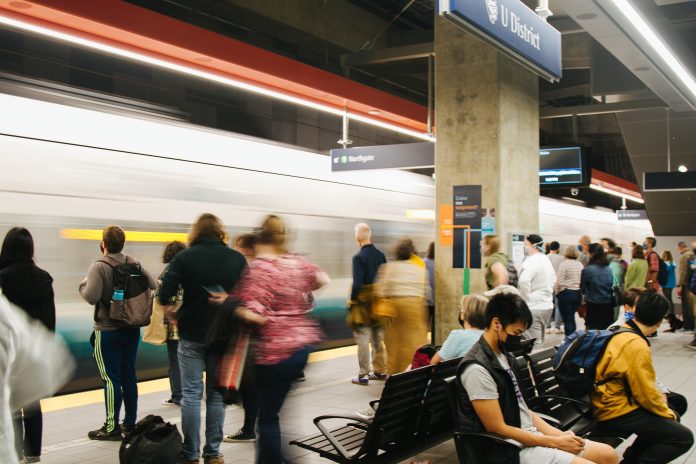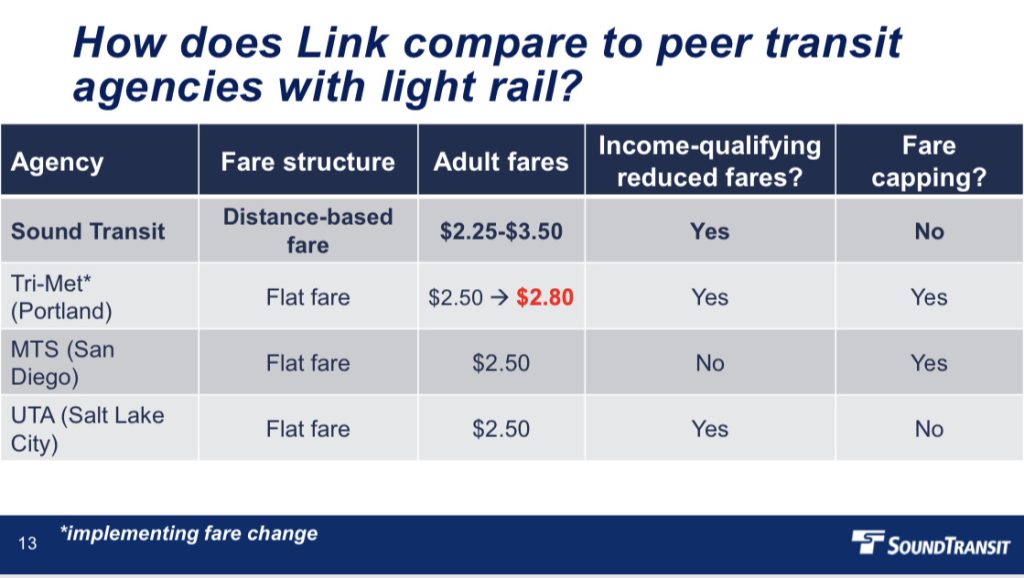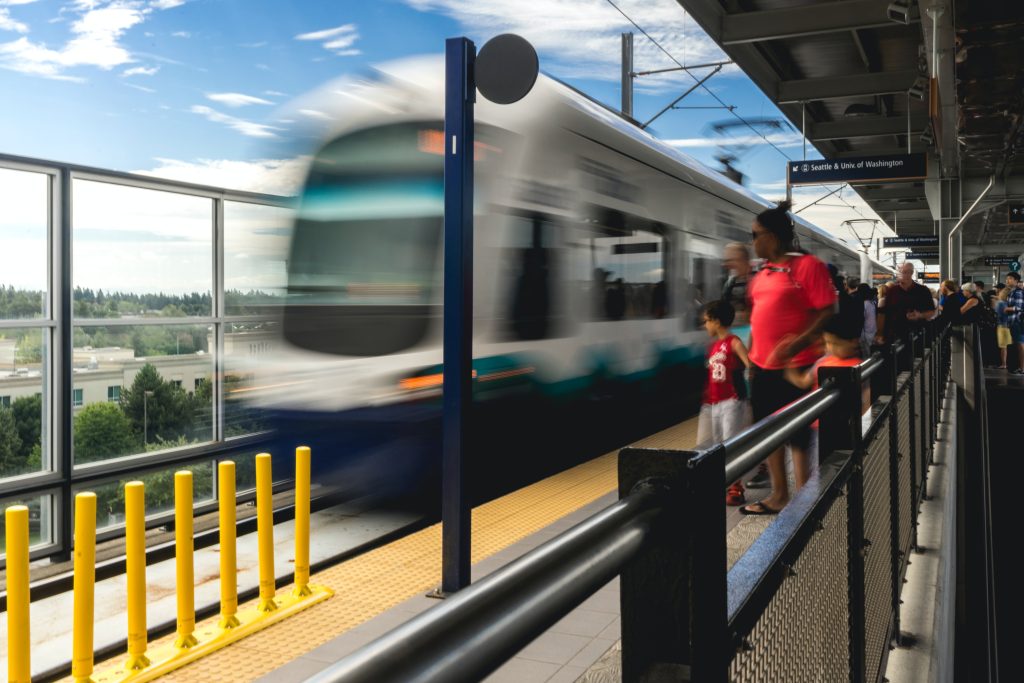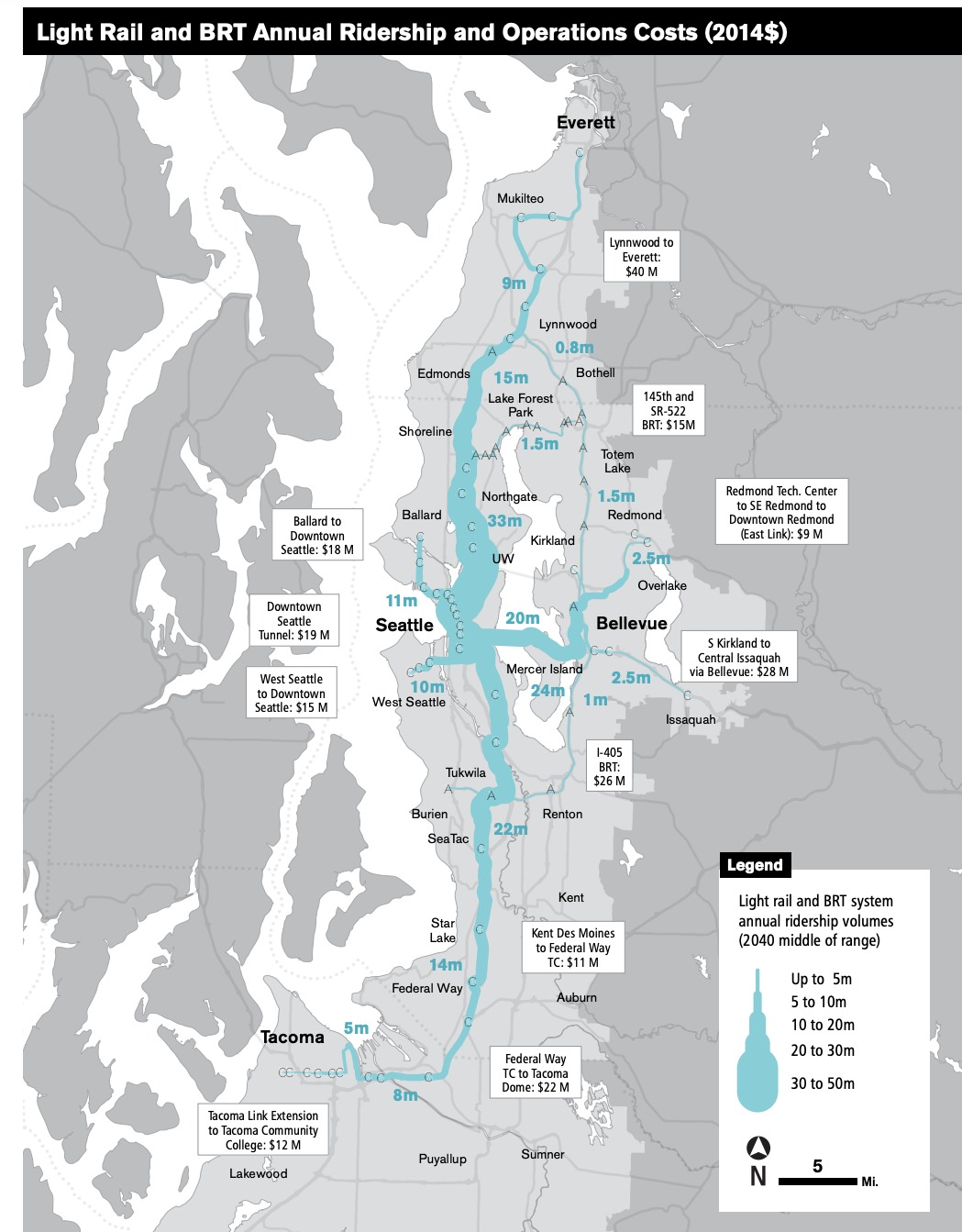
The fare structure for Link light rail ticketing could be headed toward changes, but data collected so far strongly indicates sticking to the distance-based status quo. Sound Transit is holding a public hearing on the matter on Thursday to solicit additional public feedback, but whether or not that will substantially change the agency’s trajectory remains to be seen. Sound Transit staff have promised to bring more information to a follow-on board meeting and then deliver a formal fare structure proposal on December 7.
In briefings earlier this month, agency staff delivered top-line data from public engagement efforts to test preferences around retaining distance-based fares or moving to flat fares, with distance-based fares edging out flat fares in the key metrics. A desire to consider a third option, zone-based fares, did register clearly in written public comments, but was not tested in the surveys.
Survey results favor distanced-based fares along the following margins: 50.14% overall, 51% of all current Link riders, 52% of full-fare Link riders, and 53% of frequent Link riders. A much larger share of respondents said that a distance-based fare system would be more affordable to them than a flat-fare system, representing an absolute majority. Just 53% of future Link riders favored a flat fare, an indication that many of them would be coming from the Eastside or Snohomish County where a distance-based fare system would be more costly for many trips than a flat-fare system.
Agency staff seemed to sandbag surveys like the one done for fares by saying that they aren’t usually representative of all riders, but in absence of a professionally conducted research survey and opinion polling, it’s the best data the agency has to represent rider views.
All things being equal, the data indicates that the agency should retain distance-based fares or consider a more regionally equitable alternative than a flat fare. Not only did distance-based fares receive the most absolute support in surveys, even if it only received exactly 50% support, that would ordinarily be enough to tip it into being retained since it is the status quo position.
So far, most of the agency’s work has seemed to prematurely tee up a move to a flat fare system, which some agency boardmembers have asked for. Presentations have selectively pointed to American peer agencies using flat fares and overselling the simplicity of them without really weighing tradeoffs. Agency staff has also touted the possibility of fare-capping as a benefit in moving to a flat fare system. But this month, the agency confirmed that fare-capping could be instituted for distance-based fares, too, just with a little more backend work on ORCA’s fare management system. That would entail establishing fare breaks that would have to be hit to qualify for free or reduced cost trips in a given time period (e.g., daily, weekly, or monthly).

At an agency meeting this month, Washington State Department of Transportation Secretary Roger Millar pointedly asked if the agency was looking at international examples in evaluating changes to the fare structure. Millar mentioned that he had recently visited Europe where fare structures were more robust to match rider use. Agency staff responded to say that their focus had primarily been on American transit systems, offering specious reasoning in doing so.
University Place Councilmember Kent Keel also chimed in to bring some nuance to the discussion.
“I think there’s a need for a combination of […] here’s the entry level number for the ride, but then we have some distance pieces in there,” Keel said. “But then you also work in numbers that will not discourage either the short-distance rider or only benefit the long-distance one.”
Some flavor of a distanced-based fare structure might be able to achieve that, but zone-based fares would certainly be a cleaner way to do that, especially if travel in the first two zones costs the same.
Setting aside the survey data, the case for a flat-fare system itself isn’t that strong beyond streamlining fare tables and removing the need for tapping off. Recent fare data shows that most Link riders usually don’t even need to think about tapping off at the end of a trip. That’s because they either participate in a reduced fare or free fare program (13% of riders) or have an employer-paid transit pass (41% of riders). Just 46% of Link riders actually need to worry about paying adult fares accurately to get charged the lowest applicable fare via ORCA or using tickets.
As a consequence, a large proportion of Link riders wouldn’t be impacted or benefited by a fare structure change. Sound Transit, however, pulls in a significant amount of revenue from employer-paid ORCA transit passes since this category of rider often doesn’t tap off at the end of a trip, usually charging the maximum fare on Link at no personal expense to the rider.

Regular adult fare riders are more sensitive to fare costs though. Distance-based fares seem to benefit a good chunk of these riders as survey and fare data shows, presumably since many of them live and travel within Seattle. Traveling from the Rainier Valley stations to downtown tunnel stations, for instance, only costs $2.50. With fare increases ahead, these riders could still pay less with distance-based fares than flat fares, so it’s rational that they would favor being rewarded with lower fares than long-distance suburban riders.
While fares only cover a small proportion of operational costs, a Link ride does have a real cost to it that goes up the longer someone remains onboard. It’s reasonable to expect that riders who travel shorter distances and thereby command fewer resources shouldn’t pay as much as riders traveling longer distances who use more resources. A flat-fare system doesn’t acknowledge this paradigm and treats both types of riders as the same.
Though some may debate the characterization, Link is a premium transit service because it is more frequent and faster than most local bus service. Right now, the Link fare structure doesn’t fully reflect this, but there are some clear examples of how it is a superior transit service offering. Traveling from U District Station to Capitol Hill Station, Link costs $2.50 and takes eight minutes while a King County Metro bus (Route 49) trip costs $2.75 and takes twice as long. Travel time savings are even more significant over medium urban distances, such as SeaTac/Airport station to Westlake station where Link takes about 38 minutes versus 60 minutes or so on the bus (RapidRide A Line and Route 124), and costs just $0.25 more.
Sound Transit’s ST Express better reflects that it’s a premium service over regular bus service. Fares on the service are $3.25, which are $0.50 or more than local bus service and much faster across most similar corridors. ST Express also used to charge zone-based fares when crossing county boundaries to partially factor in the distance and speed premium it offered.

As Link grows, operational costs are going to increase significantly as tracks and facilities are expanded. Ridership at the ends is expected to be fairly paltry compared to the urban core between Seattle, Bellevue, Lynnwood, and Sea-Tac Airport. Charging a premium for longer distances is therefore a rational response to better manage distribution of ridership, partially compensate for occupying limited seating for longer, and pay for low productivity segments of the system.
In the next few weeks though, we’ll see where agency staff and the board fall on this matter, which could stick with the status quo distance-based fares, move to flat fares, or pull a hat trick for a regionally equitable zone-based fare system. Riders will also surely be interested in how much fares are going up in the process (anywhere from $0.25 to $1.00, depending upon the approach chosen), how the agency might pursue fare-capping, and how the agency will set farebox recovery targets.
The public hearing on fares will be held on Thursday, November 16 at 9:30am. Comments can be made in-person at Union Station or virtually online. Doors to the Ruth Fisher Board Room will open 30 minutes prior to the public hearing at Union Station. The sign-up window for online verbal comment will open at 6:00am and close at 9:25am.
Stephen is a professional urban planner in Puget Sound with a passion for sustainable, livable, and diverse cities. He is especially interested in how policies, regulations, and programs can promote positive outcomes for communities. With stints in great cities like Bellingham and Cork, Stephen currently lives in Seattle. He primarily covers land use and transportation issues and has been with The Urbanist since 2014.

